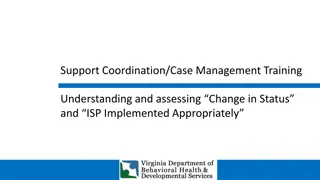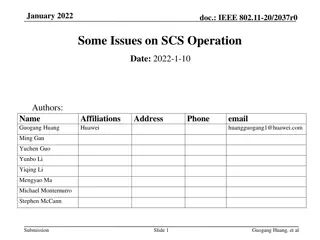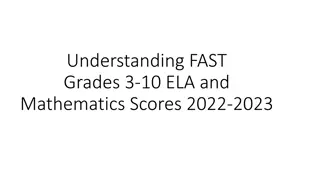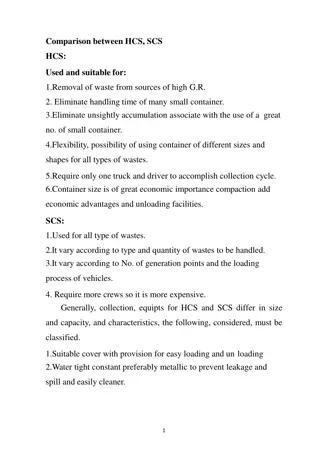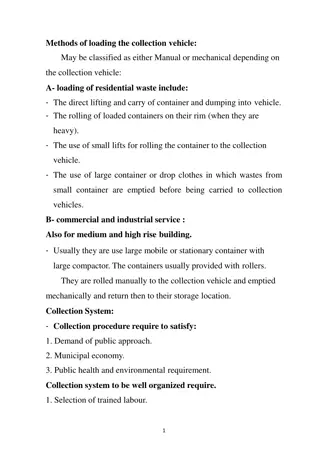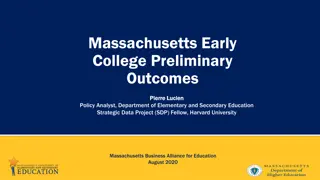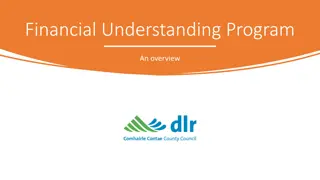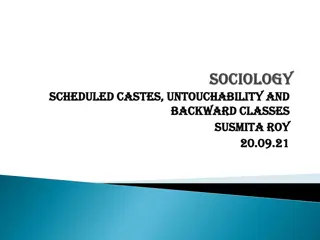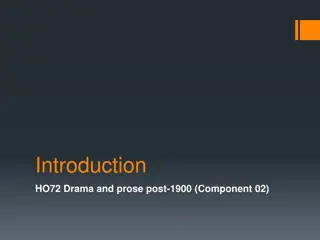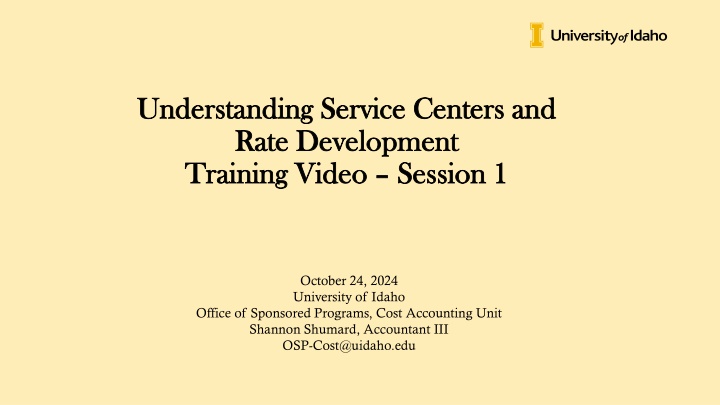
Understanding Service Centers and Rate Development Training Video
Learn about defining service centers, cost definitions, developing rates, subsidized vs. unsubsidized rates, and the role of OSP in the rate development process at the University of Idaho in this insightful training video session.
Uploaded on | 1 Views
Download Presentation

Please find below an Image/Link to download the presentation.
The content on the website is provided AS IS for your information and personal use only. It may not be sold, licensed, or shared on other websites without obtaining consent from the author. If you encounter any issues during the download, it is possible that the publisher has removed the file from their server.
You are allowed to download the files provided on this website for personal or commercial use, subject to the condition that they are used lawfully. All files are the property of their respective owners.
The content on the website is provided AS IS for your information and personal use only. It may not be sold, licensed, or shared on other websites without obtaining consent from the author.
E N D
Presentation Transcript
Understanding Service Centers and Understanding Service Centers and Rate Development Rate Development Training Video Training Video Session 1 Session 1 October 24, 2024 University of Idaho Office of Sponsored Programs, Cost Accounting Unit Shannon Shumard, Accountant III OSP-Cost@uidaho.edu
Agenda Defining service center s Service center definitions Center definitions Cost definitions What is subsidizing Components of developing rates Salary & Fringe Operating expenses Capital equipment & depreciation Short overview of subsidized vs unsubsidized rate (Examples NOT based on UI Rate Development Spreadsheet) OSP s role Rate development process
Defining Service Centers APM 20.20 Service Center Policies and Practices 20.20 Service Center Policies and Practices (uidaho.edu) A service center is defined as a university departmental unit that provides goods or services to other units within the University. If the unit only provides infrastructure design services (i.e. engineering) and those services are never charged to any sponsored projects, then that activity is excluded from these policies. Services can range from highly specialized to routine in nature and the activity is ongoing, not a one-time distribution of expense. For service centers with gross revenue of $10,000 or more, a formal rate approval is required. This review is performed by the Cost Accounting Unit of the Office of Sponsored Programs. The cost of running the service center facility or providing the product is charged to users on a rate basis. Rates are generally formulated to recover the costs of operations such as salaries, benefits, equipment depreciation, materials, and supplies expense. (See C-1) Please note that these policies have been developed to ensure compliance with federal cost principles for educational institutions contained in the Office of Management and Budget (OMB)Uniform Guidance which can be found at 2 CFR 200. The cost principles establish guidelines regarding allowable and allocable costs that may be recovered on federal grants and contracts, including costs associated with service center activities. C-1. Service Center Rates: Rates must be based upon allowable costs incurred by the service center and accounted for in the related budgets. The rates should be stated in measurable units of goods or services, based on reasonable annual estimates. They must be non-discriminatory, and calculated on a break-even basis (i.e. revenues should roughly equal expenditures). Any fund balances under or over the break-even point will be included as a rate adjustment during the next fiscal year. Rates must be applied consistently. If different rates are applied to different users, then federal grants must receive the lowest rate. A carry forward balance of approximately 15% is allowable and considered to be break-even.
Service Center Definitions Center Definitions Break-even: cumulative revenue equaling cumulative expenses, which results in zero surplus or deficit remaining balance at fiscal year end. This rarely happens to exact zero balance, so for service centers there is a grace 15% of annual revenue into surplus or deficit that is still considered break-even for the service center. Billing Rate: An amount established to charge for specific services/products. Billing Period: Billing for services must be completed consistently and in a timely manner to ensure income is appropriately matched with costs incurred to perform the service. Break-even Period: A sensible time-period over which cumulative revenue for a service/product equals cumulative expenses. The service center must show reasonable effort to bring service center back into compliance within the next rate review and document justification for deficit/surplus of funds, if continued effort is needed an approved plan must be established with OSP. Internal Users: The rate charged to customers paying with funds which are under the fiscal oversight of UI departments. Internal Billing Rate: A service center may not include F&A rates when determining the rate charged to internal users. The University s financial system generates an overhead component on grant expenses, based upon the specific F&A rate of each award. Since internal users of service centers are predominantly grant funded, incorporating indirect charges into a service center rate would create a double charging situation with indirect costs to federal funds. May be subsidized or unsubsidized (see definitions below). Surplus Operating Funds: Service centers that have accumulated surplus funds, may not transfer these funds out of the service center operating account to reduce the balance. The balance must be carried forward and used to adjust subsequent billing rates. External Users: The rate charged to any customers that are outside the University of Idaho s fiscal oversight. These are private enterprises or customers with no affiliation to UI. External Billing Rate: At a minimum, external users will be charged for the full direct costs of the service unit operation. The external rate is based on the sum of direct and F&A costs. The direct cost portion of the rate is composed of fixed and variable components. The fixed component is determined by dividing total annual fixed costs by anticipated annual billing units at full-capacity operation so that each unit of activity includes only its allocable share of fixed costs (i.e. an allocated portion). The variable cost component is determined by dividing anticipated total annual variable costs by the anticipated number of units to be sold (i.e. G&A fee, Equipment fee). The service center rate development spreadsheet automatically includes indirect rates in the rate calculation for external users. Guarantee Account: All service centers must have a guarantee account that is designated by the unit responsible for the service center. This account is a guarantee for the payment of unrecovered service center expense if the service center budget has a deficit at fiscal year-end that exceeds 15% of operating expenses, or will not be recovered through an increase in the succeeding year s rate. Carry-forward (cash reserves): The service center s balance (+ or -) at the end of one fiscal year will be used to beginning of the next fiscal year. Anything over the approved 15% carry-forward balance will be used to adjust subsequent billing rates. Subsidized (Subsidies): A rate that assumes some portion of a service center s cost is paid by external funds or any source of funds other than the service center account. These outside portion of funds were not generated by the sale of a good or service of the service center. This occurs when a center is not entirely self supported (e.g., receives partial support through State appropriations) as is characteristic of many Service Centers. Internal Charges: Service centers may charge for services to internal sponsored projects, programs, and gift accounts. Such charges must show traceable information that describes the service or product provided. The account manager, PI, and/or other persons given permission to charge the account should review charges to ensure compliance. External Charges: Service centers that charge external customers, in addition to internal customers, should review established university procedures since charges to external users may result in unrelated business income tax for the university. Sales tax, when applicable must be charged to all external users who do not provide tax-exempt certificates. If external users make up more than 20% of a service center s revenue, a separate account for external users must be established. Service centers that intend to charge external customers should review the Sales Tax (APM 20.11)for information regarding procedures. Information. Cash Transmittal/General Receipt form is available from Student Accounts. Call the cashiers at (208) 885-2137, 2138, or 2139 to order forms. For questions regarding whether a sale is considered taxable or for information on acceptable tax exemption documentation, contact General Accounting at General Accounting email. Unsubsidized: A billing rate that is calculated by dividing total cost allocated to a product or service by the number of units the service center expects to sell. Billing Unit: The basis on which services/products are offered (e.g., hours, unit price, etc.). Unit Assessed Charges: Due to the nature of service centers, the following external charges can be assessed on the service center s external billing rate, but cannot be included in the internal rate development: G&A Fee Equipment Replacement Fee
Service Center Definitions Cont. Center Definitions Cont. Capital Equipment Replacement Reserves: A separate budget must be set-up if depreciation is an element of the calculated billing rate. The unit is responsible for setting this up according to UI procedures with the help of General Accounting. An annual transfer of depreciation expense recovered is made into the 5K or > capital outlay budget category. All capital outlay must be made from this separate budget. Contact general accounting at gnrlacctg@uidaho.edu or view their website for assistance in establishing capital replacement fund account. Discounts and Waivers: Internal discounts and incentives are permitted if offered consistently. If waivers or discounts are offered to specific customer groups, the unit must provide detailed justification in addition to the proposed rates. Additionally, the department-sponsored subsidy must be sufficient to offset imputed revenue, and the unit must agree to provide detailed records of imputed revenue, as necessary. This is not recommended since it could cause a deficit to the service center. Imputed Revenue: It is important to note that when a customer is charged a rate lower than those approved and on file, the center is essentially committed to subsidizing the difference. This often occurs as a result of offering discounts and waivers to customers. Centers that anticipate using this methodology should coordinate with their associated department or college to ensure that the effect to center net income will not be an issue. The guarantee index is a subsidy funding source used to transfer funds for deficits (<15% of annual revenue) that may occur. Revenue not collected as a result of billing rate discounts and/or surcharges. For example, the internal billing rate of a Service Center is $10 per hour, but users in the department that provides subsidy are only charged $5 per hour. Total use by these uses is 10 hours. The imputed revenue is $50 ($5 per hour discount X 10 hours). Records Retention: Service centers are subject to periodic review by the OSP Service Center Team, UI s Internal Audit department and external auditors who may audit to evaluate compliance with established UI and federal policies and accounting practices. Therefore, service center activities must be adequately documented, and records maintained to support expenditures, billings, and cost transfers. (See APM 65.02)
Service Center Definitions Cont. Cost Definitions Allowable costs: Costs that the federal government allows service centers to include in internal billing rates and to fund from service center accounts. Direct cost: Costs directly associated with and allocable to service center products and services. Includes depreciation of centers capital equipment and actual expenditures incurred for salaries and wages, employee related expense, operations, and travel, regardless of funding source (i.e. service center account or subsidy). Unallowable Costs: Unallowable costs may not be budgeted or expensed by service centers because service centers often charge a significant part of their business to federally sponsored grants/contracts. Items explicitly disallowed by OMB s uniform guidance include but are not limited to: Entertainment costs Bad Debts Advertising Public relations Donations and contributions Alcoholic beverages Goods or services for personal use Fines and penalties resulting from violations of federal, state, or local laws and regulations Institutional facilities and administrative costs ( F&A ): Costs associated with general university support functions. The three largest categories are general and administrative (institutional administration), operations and maintenance, and college/departmental administration. General and administrative costs include executive management, payroll, personnel, purchasing, etc. Operations and maintenance costs include routine building maintenance and custodial services, utilities, etc. Other institutional F&A cost categories are sponsored projects administration, student administration and services, library, building depreciation, equipment depreciation, and interest expense related to capital. Fixed cost: Cost remains the same regardless of the volume of products or services sold. For example, a technician s salary or a service contract. Variable costs: Costs that change proportionally to the volume of products or services sold. For example, supplies ordered as needed to perform an analysis. External sales: Providing billable services/products to a Non-University of Idaho Customer / Department (e.g., DNA sequencing for Mayo Clinic researchers). Repair: Routine repairs and maintenance that help an asset maintain the original useful life. These are defined as keeping the equipment functioning as normal with no additional benefits to equipment improvement. These repairs can be purchased from service centers operating funds. Interdepartmental Transfer (ID*): Transfers that allow University departments to procure services/products provided by a service center and charge them to another University account. These are completed for internal customers when a journal is processed for a billing invoice. Capital Repairs / Improvements: (a) Extend the estimated useful life; (b) increased capacity; (c) substantial improvements in the quality of output; or (d) substantial reduction in operating cost. These repairs are purchased from the service centers equipment reserve fund. Net income: Total annual revenue less total annual expenses. Depreciation: The process of allocating the acquisition cost of a capital asset, over the useful life. Depreciation is an artificial construct that accountants and the government uses to account for how its use affects the market value of equipment. It allows for the cost of equipment to be spread out over the equipment s useful life. Products and services: Tangible items and activities offered by the service center to which costs are allocated and billing rates are assigned. Unallowable Depreciation: This is when equipment used by the service center is purchased with grant funds. The depreciation becomes unallowable to the allocation of the internal service center rates. Acquisition cost: The initial price of the item or items (if constructed), shipping and handling, applicable taxes, installation and ancillary costs (cords, cables, pipes, etc.) necessary for the item to function for the purpose for which it was acquired. Useful Life (Depreciable life): The time period or units of activity over which the value of a capital asset is distributed (e.g., years, miles driven for vehicles, etc.) to determine annual depreciation. Note: if you have additional questions on assets or useful life, please review APM 10.40 or reach out to Asset Accounting, assetaccounting@uidaho.edu
Subsidizing Subsidized (Subsidies): A rate that assumes some portion of a service center s cost is paid by external funds or any source of funds other than the service center account. These outside portion of funds were not generated by the sale of a good or service of the service center. This occurs when a center is not entirely self supported (e.g., receives partial support through State appropriations) as is characteristic of many Service Centers. In some instances, the University may elect to subsidize the operations of a service center, either by intentionally charging billing rates lower than costs or by accidently leaving off cost that incur a deficit covered with their guarantee index. Since subsidies can result in a loss of funds to the University, they should be provided only when there is a sound programmatic reason. If the service center has estimated subsidy from discounts these will be noted on the Service Center Rate Application page prior to the Service Center s Dean or Department Head s approval (this is also imputed revenue). Most UI service centers (SCs) rates are subsidized slightly by their department or by the University. Working through our new rate template often reveals costs the department had not previously considered and may or may not wish to charge. Our goal is to help create transparency across all service center activity. This will: 1. Allow departments to see the actual cost of providing the service and make decisions based on complete and accurate information. 2. Ensure compliance with federal regulations and in the event of an audit, we can remain confident that we are not overcharging our grants and contracts. Example of Subsidized Salary: Jane is a programmer for a service center. She has 60% of her time spent programming for the service center, and 40% of her time spent programming for her department. 50% of Jane s salary was paid by the service center 50% was paid by the department In this scenario, we can see that Jane s salary does not match how her time was spent why? The service center may not yet have a large enough customer base to cover the total cost of providing the service, or the full rate may be higher than the market will bear, so the department has chosen to pay more of her salary from departmental funds. This causes a mismatch between the activity and how the expenses are paid, which is considered a subsidy. Subsidies are allowable to internal customers only.
Total Cost to Provide a Service Total Cost to Provide a Service Understanding the purpose of each funding source Understanding the function of each funding source Service Center Service Center Service Center Service Center The primary purpose of a service center is to provide a service to departments within the University. Once a service center is developed, it should become self-supporting and will be able to absorb costs from other funding sources as financial resources diminish over time. This could be out of convenience or necessity if the service is not otherwise readily available. The activity will be ongoing. University/College/Department University/College/Department University/College/Department University/College/Department Funding used to supplement service center costs in order to offer the necessary service at a reasonable rate. The primary purpose of these funds as they relate to service centers is to supplement service center funds. This is often desirable because the services are a necessity for the faculty and on-going research projects and the department can not pay the higher cost. These supplements are at the discretion of the department. Types of funding sources can include: Gift Accounts F&A Recovery Accounts Other unrestricted accounts
Each service center has three basic cost components Each service center has three basic cost components Salary & fringe benefits Operating expenses Capital Equipment & Depreciation Let s break it down ..
Salaries & Fringe Benefits Salaries & Fringe Benefits Identify all personnel salaries that will be involved in the service center activities OSP- Cost Accounting Unit has built the Rate Development Spreadsheet, so that corresponding fringe is included with salaries. Do NOT include any personnel time that is already dedicated to sponsored projects, this is considered double- charging. Include administrative staff who are dedicated to support the service center. This is considered center management and is accounted for as a cost to the service center. Once all salaries have been identified: Determine % of effort that participating staff will devote to the service center vs. other duties Each salary (including fringe benefits) relates to a specific skillset which can be utilized to benefit one or multiple funding sources. Example: The amount of benefit each funding source receives may be different than how it is actually paid. Consider the following 2 scenarios (both are acceptable methods): Scenario 1: the benefit to the funding source (and activity) matches how the salary was paid. Example: Jane is paid 50% from the service center and 50% from the department. Her effort is spent 50% on service center work and 50% on department work. Scenario 2: the benefit to the funding source (and activity) does not match how the salary was paid (this is called a subsidy). The example for this is seen in prior subsidizing slide #7
Operating Expenses Operating Expenses (all expenses other than salary and equipment > 5k which are included in separate sections) Service center operating expenses are regular expenses that are incurred as a result of providing the service. These include fixed (i.e. service contracts) and variable (i.e. consumables) expenses incurred to provide the services or products. Each operating expense may be paid differently from how it benefits the service center activities. Operating expenses are paid in a similar way to our salary examples. They will either be: Paid from the service center or Paid from the departmental funds (subsidized) Service Center Rate Development Spreadsheet Expense history is used from prior fiscal year as a basis for estimating expenditures. Prorate components or parts, not including capital equipment, that are not purchased annually but will eventually need replacement. When prorating expenses these need to be expected cost (actually known not hypothetical) that will be incurred within the next fiscal year or two. The calculation should be based on quotes or detailed analysis and have a reasonability check that these cost are within what the rate can sustain (or have prior approval that subsidy will cover portion of cost).
How the operating expenses are paid How the operating expenses are paid: Paid by the Service Center: This portion of the operating expenses are incurred to provide services to customers. If there were NO service center activity, these expenses would not occur. The costs are passed on to the customers through the rate. Paid by the Department: This portion of the operating expenses is considered a subsidy to the service center. These expenses can also be departmental expenditures which are unrelated to the service center s activity. If service center costs are paid from departmental funds, the costs are not passed on to the internal customers, but they are reflected in the worksheet as a subsidized cost.
Capital Equipment Capital Equipment Capital equipment are items that have a value equal to or greater than $5,000 and a useful life greater than one year. Equipment used in the course of service center business should be listed in the worksheet regardless of where it was purchased. Depreciation of each piece of capital equipment and whether it is passed on through the service center rate will be based on how the equipment is purchased and used. Depreciation Depreciation It is calculated by asset accounting at the end of the fiscal year and expensed on UI s financial statements, which enables service centers to recover this amount for future purchases of service center equipment. Depreciation for grant funded equipment will be listed on the spreadsheet, but will NOT be calculated into the internal billing rate. Salary Operating and Deprec Exp tab You will see under Capital Equipment and Depreciation section that there is a Unallowable Equipment column, which is prior to the final total column. This is where you will put the % of how much grant funds were used to purchase the equipment Useful Life Useful Life Asset Accounting will assign a useful life to each asset, which OSP- Cost Accounting Unit uses in the rate development spreadsheet to assist with the depreciation recovery calculation for each asset. Each asset type has different guidelines to the useful life assigned, if you have questions, please reach out to Asset Accounting for guidance.
Equipment Purchases and Use Equipment Purchases and Use Equipment purchased through grants etc. with federal funds: The service center can use the equipment in providing services and it should be listed in the worksheet. However, the depreciation cannot be charged to customers through the internal billing rate. This is because service center customers are often researchers who pay for these services with grant funds. Since the Federal government funded the purchase of the equipment, charging them for depreciation on it through the service center rate, would be double charging them. This is not allowable. The reason these items are included in the worksheet is because it is necessary to charge external customers for this depreciation. This will ensure that we are not subsidizing the cost to external customers, and they are paying their share of the costs. Equipment purchased by the University/Department: This can be used by the service center, and the depreciation can and should be part of the service center rate. The depreciation included in the service center rate will be captured in a separate budget to allow for future equipment replacement funds. Equipment purchased by the Service Center: The depreciation on service center purchased equipment can and should be included in the service center rate. The depreciation included in the service center rate will be captured in a separate budget to allow for future equipment replacement funds. It is not recommended to subsidize equipment on the rate development spreadsheet for internal customers since this is the service centers only method for capturing the depreciation for future equipment purchases.
Full Rate Example: Total Cost of Providing Services: Full Rate Example: Total Cost of Providing Services: The fully burdened rate will be charged to customers who are not part of the University (external customers) to ensure that we are not subsidizing the activity, and they are paying what it actually costs the university to supply the service. Service Center Rate Example Salaries and fringe benefits $400,000 Operating expense Travel $1,000 $1,000 Operating expense $50,000 $50,000 Equipment 5k $3,000 $3,000 Capital equipment 5k (cost of equipment was $100k with a useful life of 5 years) Annual depreciation $20,000 Total cost $474,000 Number of services provided annually 20,000 Rate per service $23.70
Subsidized rate example: Subsidized rate example: University departments (internal customers) can be charged a lower (subsidized) rate than external customers to make the services more affordable to researchers. Recall: the actual cost of equipment can not be charged through the rate. Only the annual depreciation amount per year. We can depreciate the portion of equipment purchased by university funds in the rate, but not the portion purchased on grants. Service Center Rate (all costs related to providing services) Grant (Federal) paid expenses (subsidy) University/Dept. paid expenses (subsidy) Service Center paid expenses used in the rate Total (fully burdened rate) Salaries and fringe benefit - $200,000 $200,000 $400,000 Operating expense Travel - $1,000 - $1,000 Operating expense - $10,000 $25,000 $50,000 Equipment 5k - - $3,000 $3,000 Capital equipment 5k (cost of equipment is $100k with a useful life of 5 years) $50,000 $50,000 - Annual depreciation **$10,000 - $10,000 $20,000 We want to include grant paid subsidies into calculation, which are allowable because we are not charging for those items in the internal billing rate. These don t create a double charging situation since it s only calculated into external billing rates. Total cost $10,000 $211,000 $238,000 $474,000 Number of services provided 20,000 20,000 Rate per service $11.90 $23.70 Subsidy $10,000 $211,000 **$10,000 depreciation for equipment purchased on federal $ may not be used to calculate the service center rate recall that this would create double charging to the federal government.
What is OSP What is OSP- - Cost Accounting Unit s role? Accounting Unit s role? Cost We will work through the development of your service center with you. We are here to help you understand the process, and make it as simple and positive for you as we can. There are many ways to structure your service center. We are here to help you find the best fit for you. We will answer your questions, and research answers to unique problems as they relate to service centers.
Rate Development Process On a biennial basis rates will be reviewed by the OSP- Cost Accounting Unit. Please note that some of the requested details on the updated rate sheets, such as information regarding equipment list and location/room # s are to benefit the University during the F&A rate development and rate sheets should be completed to the best of your knowledge. First Step: First Step: OSP- Cost Accounting Unit will begin the Service Center s rate sheet by assisting with pulling salary & fringe rates, transaction details for prior fiscal years expenses, and list for capital equipment (for the department). The information will be carried over from the prior rate development only - Second Step: Second Step: The Service Centers Fiscal Contact/Worksheet Preparer will review and provide updated data for the service center. 1. Rate Application tab - review and ensure that all information is updated, and provide a guaranteed index (only used in case of a deficits >15% of revenue) a. For the Location and Room # please help us by giving exact location(s) of the Service Center. 2. Information tab Most of the details for this tab have been completed by OSP- Cost Accounting Unit, however column I for Estimated # of annual units will need to be update each rate development. Verify that all the service names look correct and there have been no new services added. 3. Salary Operating and Deprec Exp Most of the review will take place on this tab. The Service Centers Fiscal Contact/Worksheet Preparer will need to start at the top section. a. Salaries and Fringe Benefits (row 11) and review that all staff are correct. OSP- Cost Accounting Unit will only have the staff from the prior rate sheet, so please provide updates if needed. b. Then Operating Expenses (row 56) will be the next section, which will be pulled from the prior fiscal years transaction detail report and provided by OSP- Cost Accounting Unit. If additional funds were used to subsidize expenses on the service center, please provide that details to OSP- Cost Accounting Unit to be included. Also, if you know of an upcoming expense will be coming up that could alter the new rates, please include the cost/estimated expense. Please note the details into the Description Notes tab. c. Below that will be Capital Equipment and Depreciation (row 139) that will need to be updated by the service center worksheet preparer. Please mark assets that have been disposed or add in new equipment. If equipment s useful life or other details are unknown the spreadsheet has equipment list tab provided by department to help find details or please reach out to OSP- Cost Accounting Unit with the equipment s Ptag if unable to identify on list. c.1 Please do your best to provide building location and room #. If unknown, please leave it blank and add a comment below (row 259) for last known room information / where you believe it s located. This will be used for F&A negotiation in case of inventory review.
Rate Development Process Cont. Third Step: The Service Centers Fiscal Contact/Worksheet Preparer will work on allocating out expenses to the appropriate services, which is completed on the Salary Operating and Deprec Exp tab. In the columns next to each section of expenses, you ll see the services to provide how much % of the expense should be allocated to each service This will be completed for all three sections under the Salary Operating and Deprec Exp tab. Final Step: The Service Centers Fiscal Contact/Worksheet Preparer will send rate sheet to OSP- Cost Accounting Unit to receive confirmation that the rate sheet is ready for final approvals. Once confirmed, the Service Center will have their Dean or Department Head sign the Rate Application page at the bottom for their approval. This can be electronically signed in excel. Then the final rate sheet with the approvers signature will be sent to the OSP- Cost Accounting Unit to be sent on to be approved by OSP s Assistant Director of Sponsored Accounting and University Controller.
Documentation and Links Service Center Documentation - OSP University Policy Administrative Procedures Manual Service Centers - Division of Finance and Administration | University of Idaho (uidaho.edu) APM 20.20 Service Center Policies and Practices 20.20 Service Center Policies and Practices (uidaho.edu) Owner: Position: Office of Sponsored Programs Director Email: osp@uidaho.edu Contact cost accounting at osp-cost@uidaho.edu Training Video and PowerPoint Slides Definitions Blank Rate Development Template Banner Salaries Instructions Approved Service Centers - DFA Approved Service Centers - Division of Finance and Administration | University of Idaho (uidaho.edu) Contacts for each service center and current approved rates APM 20.11 - Idaho Sales Tax Collection 20.11 - Idaho Sales Tax Collection (uidaho.edu) Owner: Email: controller@uidaho.edu Asset Accounting Asset Accounting - Division of Finance and Administration | University of Idaho (uidaho.edu) APM 10.40 Property Inventory and Products 10.40 - Property Inventory and Products (uidaho.edu) Owner: Position: Director, Facilities Email: facilities@uidaho.edu Contact asset accounting at assetaccounting@uidaho.edu Forms Instructions Informative Links General Accounting APM 65.02 Records Inventory, Retention and Disposition 65.02 - Records Inventory, Retention and Disposition (uidaho.edu) Owner: Position: Vice President of Information Technology and Chief Information Officer, Information Technologies Email: records@uidaho.edu General Accounting - Division of Finance and Administration | University of Idaho (uidaho.edu) Contact general accounting at gnrlacctg@uidaho.edu Contact General Accounting - For questions regarding whether a sale is considered taxable or for information on acceptable tax exemption documentation or to setup new fund/indexes New Fund/Index Request Form Cost Transfer and Funds Transfer Instructions Revenue Code List and Expense Code Lookup Tool APM 20.06 Cash Deposits 20.06 - Cash Deposits (uidaho.edu) Owner: Email: controller@uidaho.edu Student Accounts General Information - Student Accounts | University of Idaho (uidaho.edu) Contact student accounts at acctrec-wires@uidaho.edu Cash Transmittal/General Receipt form is available from Student Accounts. Call the cashiers at (208) 885-2137, 2138, or 2139 to order forms.



